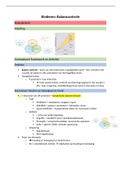Summary
Samenvatting Kinesitherapie Bij Kinderen: Balanscontrole
- Course
- Institution
Samenvatting van het deel balans controle onder het vak Kinesitherapie bij kinderen. De samenvatting is een combinatie van notities tijdens de les en de powerpoints. Het bevat tekeningen en afbeeldingen ter verduidelijking van de leerstof. De hoofdstukken: - Assessment balans controle - Beh...
[Show more]



